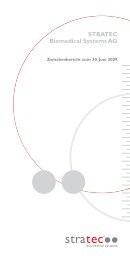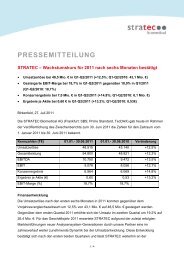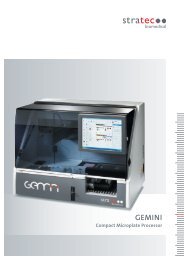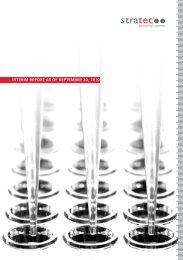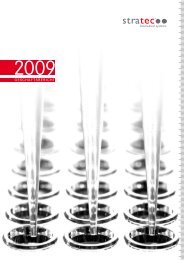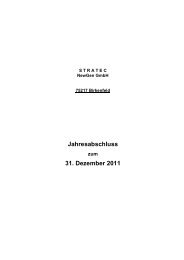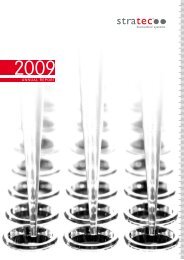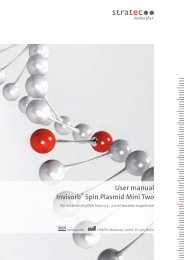PSP Spin Stool DNA Kit - STRATEC Biomedical AG
PSP Spin Stool DNA Kit - STRATEC Biomedical AG
PSP Spin Stool DNA Kit - STRATEC Biomedical AG
You also want an ePaper? Increase the reach of your titles
YUMPU automatically turns print PDFs into web optimized ePapers that Google loves.
Intended useThe <strong>PSP</strong> ® <strong>Spin</strong> <strong>Stool</strong> <strong>DNA</strong> <strong>Kit</strong> has been designed for fast and efficient purification of genomicand microbial <strong>DNA</strong> from up to 400 mg fresh and frozen human or animal stool samples or fromother sample types with high concentrations of PCR inhibiting components.The purified <strong>DNA</strong> can be used for in-vitro diagnostic analysis.The <strong>PSP</strong> ® <strong>Spin</strong> <strong>Stool</strong> <strong>DNA</strong> Plus <strong>Kit</strong> is an integrated system for collection, transportation andstorage of fecal samples and subsequent <strong>DNA</strong> purification. The kit has been designed forisolation of <strong>DNA</strong> from pathogenic microorganisms, as well as for isolation of <strong>DNA</strong> from the hostorganism. Furthermore, it is possible to extract nucleic acids from food and feed residues of plantor animal origin from the stool sample.The protocols for the isolation and all buffers are optimized for a high yield as well as a high purity.All hands on steps are reduced to a minimum.Any diagnostic results generated using the sample preparation procedure in conjunction with anydownstream diagnostic assays should be interpreted with regard to other clinical or laboratoryfinding.THE PRODUCT IS INDENTED FOR USE BY PROFESSIONAL USERS ONLY, SUCH ASTECHNICIANS, PHYSICIANS AND BIOLOGISTS TRAINED IN MOLECULAR BIOLOGICALTECHNIQUES. It is designed to be used with any downstream application employing enzymaticamplification or other enzymatic modifications of <strong>DNA</strong> followed by signal detection oramplification. Any diagnostic results generated by using the sample preparation procedure inconjunction with any downstream diagnostic assay should be interpreted with regard to otherclinical or laboratory findings.To minimize irregularities in diagnostic results, adequate controls for downstream applicationsshould be used.The kit is in compliance with EU Directive 98/79/EC on in vitro medical devices. But it is not for in-vitro diagnostic use incountries where the EU Directive 98/79/EC on in vitro medical devices is not recognized.Product use limitationThe kit is not validated for the isolation of genomic <strong>DNA</strong> from cultured or isolated cells, fromtissue, swabs, dried blood stains, or cell free body fluid, like synovial fluid and urine, or thepurification of RNA. The application of the kit for isolation and purification of viral <strong>DNA</strong> has notbeen evaluated.The included chemicals are only useable once.Differing of starting material or flow trace may lead to inoperability; therefore neither a warrantynor guarantee in this case will be given, neither implied nor express.The user is responsible to validate the performance of the <strong>STRATEC</strong> Molecular Product for anyparticular use. <strong>STRATEC</strong> Molecular does not provide for validation of performance characteristics ofthe Product with respect to specific applications. <strong>STRATEC</strong> Molecular Products may be used e.g.inclinical diagnostic laboratory systems conditioned upon the complete diagnostic system of thelaboratory the laboratory has been validated pursuant to CLIA’ 88 regulations in the U.S. orequivalents in other countries.All Products sold by <strong>STRATEC</strong> Molecular are subject to extensive quality control procedures(according to ISO 9001-2000 and ISO EN 13485) and are warranted to perform as described herein.Any problems, incidents or defects shall be reported to <strong>STRATEC</strong> Molecular immediately upondetection thereof.The chemicals and the plastic parts are for laboratory use only; they must be stored in thelaboratory and must not be used for purposes other than intended.The Product with its contents is unfit for consumption.7 <strong>PSP</strong> ® <strong>Spin</strong> <strong>Stool</strong> <strong>DNA</strong> <strong>Kit</strong> 0213<strong>PSP</strong> ® <strong>Spin</strong> <strong>Stool</strong> <strong>DNA</strong> Plus <strong>Kit</strong> 0213
Safety informationWhen working with chemicals, always wear a suitable lab coat, disposable gloves and protectivegoggles and avoid skin contact. Heed the legal requirements for working with biological material!For more information, please consult the appropriate material safety data sheets (MSDS). Theseare available online in convenient and compact PDF format at www.stratec.com for each<strong>STRATEC</strong> Molecular kit and whose kit component.If the buffer bottles are damaged or leaking, wear gloves and protective goggles when discardingthe bottles in order to avoid any injuries.<strong>STRATEC</strong> Molecular has not tested the liquid waste generated by the <strong>PSP</strong> ® <strong>Spin</strong> <strong>Stool</strong> <strong>DNA</strong> <strong>Kit</strong>and the <strong>PSP</strong> ® <strong>Spin</strong> <strong>Stool</strong> <strong>DNA</strong> Plus <strong>Kit</strong> procedures for residual infectious materials. Contaminationof the liquid waste with residual infectious materials is highly unlikely, but cannot be excludedcompletely. Therefore, liquid waste must be considered infectious and must be handled anddiscarded according to local safety regulation.Below is listed European Community risk and safety phrases for the components of the <strong>PSP</strong> ®<strong>Spin</strong> <strong>Stool</strong> <strong>DNA</strong> <strong>Kit</strong> and of the <strong>PSP</strong> ® <strong>Spin</strong> <strong>Stool</strong> <strong>DNA</strong> Plus <strong>Kit</strong> to which they applyLysis Buffer PWash Buffer IdangerH319 P305-351-338warningH302-312-332-412 EUH032 P273Proteinase KdangerH315-319-334-335 P280-305-351-338-310-405H319: Causes serious eye irritation.H315: Causes skin irritation.H334: May cause allergy or asthma symptoms or breathing difficulties if inhaled.H335: May cause respiratory irritation.H302: Harmful if swallowed.H312: Harmful in contact with skin.H332: Harmful if inhaled.H412: Harmful to aquatic life with long lasting effects.EUH032:Contact with acids liberates very toxic gas.P233: Keep container tightly closed.P305+P351+P338:IF IN EYES: Rinse cautiously with water for several minutes. Remove contact lenses, ifpresent and easy to do. Continue rinsing.P280: Wear protective gloves/protective clothing/eye protection/face protection.P310: Immediately call a POISON CENTER or doctor/physician.P405: Store locked up.P273: Avoid release to the environment.Emergency medical information can be obtained 24 hours a day from infotrac:outside of USA: 1 – 352 – 323 – 3500in USA : 1 – 800 – 535 – 5053<strong>PSP</strong> ® <strong>Spin</strong> <strong>Stool</strong> <strong>DNA</strong> <strong>Kit</strong> 0213<strong>PSP</strong> ® <strong>Spin</strong> <strong>Stool</strong> <strong>DNA</strong> Plus <strong>Kit</strong> 0213
Product characteristic of the <strong>PSP</strong> ® <strong>Spin</strong> <strong>Stool</strong> <strong>DNA</strong> <strong>Kit</strong>Starting material Yield Time Ratiomax. 200 mg fecal sampleup to 50 µg (depends onstarting material)about 45 min(incl. lysis time)A 260 : A 2801,4 – 1,8The <strong>PSP</strong> ® <strong>Spin</strong> <strong>Stool</strong> <strong>DNA</strong> <strong>Kit</strong> allows rapid and efficient isolation of high quality <strong>DNA</strong> from upto 200 mg of fresh or frozen stool sample. <strong>Stool</strong> samples typically contain many compoundsthat can degrade <strong>DNA</strong> and inhibit downstream enzymatic reactions. To ensure the removal ofthese contaminants the <strong>PSP</strong> ® <strong>Spin</strong> <strong>Stool</strong> <strong>DNA</strong> <strong>Kit</strong> contains tubes with InviAdsorb andoptimized essential washing conditions to remove all potent inhibitors very efficiently. So thesimple <strong>PSP</strong> ® <strong>Spin</strong> procedure yields pure <strong>DNA</strong> ready to use in less than 1h.A rigorous prelysis step using Zirconia Beads II with optimized prelysis buffer under hightemperatures is followed by a preincubation of the sample with InviAdsorb to remove PCRinhibitors. Undissolved particles and PCR inhibitors bound to InviAdsorb are removed by acentrifugation step. The following Proteinase K digestion ensures high yields also from grampositive bacteria. <strong>Stool</strong> contains a range of <strong>DNA</strong> e.g. host <strong>DNA</strong> from colon epithelial cells,parasite <strong>DNA</strong>, bacterial <strong>DNA</strong>, <strong>DNA</strong> from food or <strong>DNA</strong> from gastrointestinal pathogens. Thechoise of different lysis conditions allows the enrichment or a reduction of the content ofbacterial <strong>DNA</strong> in the total <strong>DNA</strong>. All impurities are removed very efficiently during washingsteps and the purified <strong>DNA</strong> is eluted directly in a low-salt buffer.No phenol/chloroform extraction or ethanol precipitation is necessary. The kit providesreproducible recovery rates of highly purified <strong>DNA</strong>, ready to use in any downstreamapplication. The isolated <strong>DNA</strong> can be stored at -20°C for later use.Due to the high purity, the isolated total <strong>DNA</strong> is suitable for a broad panel of downstreamapplications (see below) or can be stored at -80°C for subsequent use.ooooooPCR ∗ applicationsRFLP-analysisHybridizationGenetic typingPathogen typingMutation analysisNo toxic or hazardous chemicals like phenol/chloroform or ß-Mercaptoethanol are used.Traditional time-killing procedures can be replaced using the <strong>PSP</strong> ® <strong>Spin</strong> <strong>Stool</strong> <strong>DNA</strong> <strong>Kit</strong>.To increase robustness of PCR assays using <strong>DNA</strong> isolated from stool samples, the addition ofBSA to a final concentration of 0.1 µg/ µl to the PCR mixtures is recommended. In <strong>DNA</strong>eluates from feces, the ratio of target <strong>DNA</strong> to background <strong>DNA</strong> is often very low. To increasethe specificity of downstream PCR assays, the use of the InviTaq Hot Start <strong>DNA</strong>Polymerase (see ordering information’s, page 31) is recommended. The combination of the<strong>PSP</strong> ® <strong>DNA</strong> <strong>Stool</strong> sample preparation and the use of BSA and InviTaq Hot Start <strong>DNA</strong>Polymerase in downstream amplification maximize PCR robustness and specificity whenamplifying <strong>DNA</strong> prepared from stool samples.*) The PCR method is covered by U.S. Patents 4,683,195 and 4,683,202 owned by Hoffmann-LaRoche Inc. Thepurchase of the <strong>PSP</strong> ® <strong>Spin</strong> <strong>Stool</strong> <strong>DNA</strong> <strong>Kit</strong> cannot be construed as an authorization or implicit licence to practicePCR under any patents held by Hoffmann-LaRoche Inc.<strong>PSP</strong> ® <strong>Spin</strong> <strong>Stool</strong> <strong>DNA</strong> <strong>Kit</strong> 0213<strong>PSP</strong> ® <strong>Spin</strong> <strong>Stool</strong> <strong>DNA</strong> Plus <strong>Kit</strong> 0213
Product characteristic of the <strong>PSP</strong> ® <strong>Spin</strong> <strong>Stool</strong> <strong>DNA</strong> Plus <strong>Kit</strong>Starting material Yield Time Ratio1.4 ml <strong>Stool</strong> <strong>DNA</strong> Stabilizerwith stool homogenateup to 50 µg (depends onstarting material)about 45 min(incl. lysis time)A 260 : A 2801,4 – 1,8The <strong>PSP</strong> ® <strong>Spin</strong> <strong>Stool</strong> <strong>DNA</strong> Plus <strong>Kit</strong> combines the collection of stool samples, the storage andstabilization of the stool specimen without any degradation of the <strong>DNA</strong> with a very efficient andfast isolation of high quality total <strong>DNA</strong>. The <strong>PSP</strong> ® <strong>Spin</strong> <strong>Stool</strong> <strong>DNA</strong> Plus <strong>Kit</strong> can be used forisolation of <strong>DNA</strong> from pathogenic microorganism, as well as for isolation of <strong>DNA</strong> from hostorganism.The <strong>PSP</strong> ® <strong>Spin</strong> <strong>Stool</strong> <strong>DNA</strong> Plus <strong>Kit</strong> uses a stabilizing reagent, the <strong>Stool</strong> <strong>DNA</strong> Stabilizer, whichenables the storage of the stool samples after collection without cooling under ambienttemperature for at least 3 days.The system combines the use of the <strong>Stool</strong> Collection Tubes prefilled with the <strong>Stool</strong> <strong>DNA</strong>Stabilizer for collection, storage and stabilization of the stool specimen without any degradationof the <strong>DNA</strong> during transportation and the prelysis of bacteria with a very efficient and fast isolationof high quality <strong>DNA</strong> from stool sample. In addition to the inactivation of DNases, the <strong>Stool</strong> <strong>DNA</strong>Stabilizer preserves the microorganism titer. Furthermore, the <strong>Stool</strong> <strong>DNA</strong> Stabilizer enablesprelysis of gram positive or negative bacteria. For the <strong>DNA</strong> extraction process only a smallamount of the total volume will be used, the residual sample can be used for further extractions ora long term storage at -20°C.<strong>Stool</strong> samples typically contain many components that can degrade <strong>DNA</strong> and inhibit downstream enzymatic reactions. Therefore the <strong>PSP</strong> ® <strong>Spin</strong> <strong>Stool</strong> <strong>DNA</strong> Plus <strong>Kit</strong> containsInviAdsorb, a reagent that efficiently adsorbs these components at the beginning of thepurification process and additionally optimized essential washing conditions for the finalremoval of the last traces of all potent inhibitors. (See more to the procedure at page 11and19.)Due to the high purity, the isolated <strong>DNA</strong> is suitable for a broad panel of downstreamapplications (see below) or can be stored at –20°C for later use.oooooooPCR applicationsRFLP analysisHybridizationGenetic typingPathogen typingMutation analysisPaternity testingTo purify high molecular weight total <strong>DNA</strong> using magnetic beads, <strong>STRATEC</strong> Molecular offersdifferent kits in single sample format as well as 15 well or in 96 format, the InviMag ® <strong>Stool</strong> <strong>DNA</strong>Mini <strong>Kit</strong> for use on the InviMag Rack, the InviMag ® <strong>Stool</strong> <strong>DNA</strong> Mini <strong>Kit</strong> KFmL and KF96 foruse on the KingFisher workstations.*) The PCR method is covered by U.S. Patents 4,683,195 and 4,683,202 owned by Hoffmann-LaRoche Inc. Thepurchase of the <strong>PSP</strong> ® <strong>Spin</strong> <strong>Stool</strong> <strong>DNA</strong> Plus <strong>Kit</strong> cannot be construed as an authorization or implicit licence topractice PCR under any patents held by Hoffmann-LaRoche Inc.<strong>PSP</strong> ® <strong>Spin</strong> <strong>Stool</strong> <strong>DNA</strong> <strong>Kit</strong> 0213<strong>PSP</strong> ® <strong>Spin</strong> <strong>Stool</strong> <strong>DNA</strong> Plus <strong>Kit</strong> 0213
ProcedureLysis<strong>Stool</strong> samples are lysed in Lysis Buffer P under denaturing conditions at high temperatures.Human cells lyse efficiently at RT, bacterial cells and those of other pathogens in the stoolsample are efficiently lysed by incubation at 95°C. This is recommended for detection of cellsthat are difficult to lyse (e.g. gram positive bacteria).Note: The total <strong>DNA</strong> concentration in the lysate will be increased 3-5 fold by lysis at 95°C and theratio of non human to human <strong>DNA</strong> will increase.Removal of PCR inhibitorsAfter lysis procedure <strong>DNA</strong> damaging substances and PCR inhibitors which are present in thefeces are adsorbed efficiently to the InviAdsorb matrix. InviAdsorb is provided veryconvenient in safe lock tubes and the lysate must only be mixed with the matrix. The boundcontaminations and cell debris are pelleted by centrifugation. The supernatant contains theprecleaned <strong>DNA</strong>.Protein digestionProteinase K is added to the supernatant to digest and degrade proteins during theincubation at 70°C.Binding of total <strong>DNA</strong>After adding Binding Buffer A to the supernatant, the mixture is transferred to the spincolumns and nucleic acids are bound to the membrane of the RTA <strong>Spin</strong> Filter during a briefcentrifugation step.Optimal salt concentrations and pH conditions in the lysate ensure that remains of digestedproteins and other contaminations, which can inhibit downstream enzymatic reactions, are notretained on the Invisorb membrane.Removing residual contaminants<strong>DNA</strong> bound to the Invisorb membrane is washed in three centrifugation steps. Contaminantsare efficiently and completely removed using Wash Buffer I and II, while the nucleic acidsremain bound to the membrane.ElutionThe nucleic acids are eluted in low salt buffer from the membrane using 100 - 200 µl ElutionBuffer. The eluted nucleic acids are ready to use in different subsequent tests.Yield and quality of total <strong>DNA</strong>The amount of purified <strong>DNA</strong> in the <strong>PSP</strong> ® <strong>Spin</strong> <strong>Stool</strong> <strong>DNA</strong> <strong>Kit</strong> procedure from feces, dependson the health status of the donor, bacteria content, sample source, transport, storage, andage. A typical yield is 10 – 80 µg, a typical <strong>DNA</strong> concentration is 50 – 300 ng/ µl. Yield andquality of isolated genomic <strong>DNA</strong> is suitable for any molecular-diagnostic detection system. Thediagnostic tests should be performed according to manufacturers’ specifications.<strong>PSP</strong> ® <strong>Spin</strong> <strong>Stool</strong> <strong>DNA</strong> <strong>Kit</strong> 0213<strong>PSP</strong> ® <strong>Spin</strong> <strong>Stool</strong> <strong>DNA</strong> Plus <strong>Kit</strong> 0213
Important notesImportant points before starting a protocolImmediately upon receipt of the Product, inspect the Product and its components as well asthe package for any apparent damages, correct quantities and quality. If there are anyunconformities you have to notify <strong>STRATEC</strong> Molecular in writing with immediate effect uponinspection thereof. If buffer bottles are damaged, contact the <strong>STRATEC</strong> Molecular TechnicalServices or your local distributor. In case of liquid spillage, refer to “Safety Information” (seepage 7). Do not use damaged kit components, since their use may lead to poor kitperformance.○○○○○○○○Always change pipet tips between liquid transfers. To avoid cross-contamination, werecommend the use of aerosol-barrier pipet tips.All centrifugation steps are carried out at room temperature.When working with chemicals, always wear a suitable lab coat, disposable gloves, andprotective goggles.Discard contaminated gloves.Do not combine components of different kits unless the lot numbers are identical.Avoid microbial contamination of the kit reagents.To minimize the risk of infections from potentially infectious material, we recommend workingunder laminar air-flow until the samples are lysed.This kit should only be used by trained personnel.Preparing reagents and buffersfor the <strong>PSP</strong> ® <strong>Spin</strong> <strong>Stool</strong> <strong>DNA</strong> <strong>Kit</strong> and <strong>PSP</strong> ® <strong>Spin</strong> <strong>Stool</strong> <strong>DNA</strong> Plus <strong>Kit</strong>1. Adjust the thermomixer to 70°C.2. Dissolve Proteinase K in ddH 2 O.3. Warm up the needed amount of Elution Buffer to 70°C, (100 - 200 µl Elution Buffer areneeded per sample).4. Heat heating blocks (e.g. thermomixer) to 70°C and 95 °C.5. Label the needed amount of 2.0 ml RTA <strong>Spin</strong> Filter Sets.6. Label the needed amount of 1.5 ml Receiver Tubes (per sample: 1 Receiver Tube), addthe needed amount of ethanol to the Wash Buffer I and II (see <strong>Kit</strong> contents, page 3 and4).<strong>PSP</strong> ® <strong>Spin</strong> <strong>Stool</strong> <strong>DNA</strong> <strong>Kit</strong> 0213<strong>PSP</strong> ® <strong>Spin</strong> <strong>Stool</strong> <strong>DNA</strong> Plus <strong>Kit</strong> 0213
5 total <strong>DNA</strong> extractions:add 250 µl ddH 2O to Proteinase K, mix thoroughly and store the tube at -20°CBinding Buffer A, Wash Buffer I and II are ready to use50 total <strong>DNA</strong>-extractions:<strong>PSP</strong> ® <strong>Spin</strong> <strong>Stool</strong> <strong>DNA</strong> <strong>Kit</strong> : add 11 ml 99.7% Isopropanol to the Binding Buffer A. Mix by intensive shaking byinverting for 1 min.<strong>PSP</strong> ® <strong>Spin</strong> <strong>Stool</strong> <strong>DNA</strong> Plus <strong>Kit</strong> : add 21 ml 99.7% Isopropanol to the Binding Buffer A. Mix by intensiveshaking by inverting for 1 min.Shortly before use mix by inverting several times.add 1.5 ml ddH 2O to Proteinase K, mix thoroughly and store the tube at -20°Cadd 30 ml 96-100% ethanol to the bottle Wash Buffer Iadd 42 ml 96-100% ethanol to each bottle Wash Buffer IImix thoroughly and always keep the bottle firmly closed250 total <strong>DNA</strong>-extractions:<strong>PSP</strong> ® <strong>Spin</strong> <strong>Stool</strong> <strong>DNA</strong> <strong>Kit</strong> : add 21 ml 99.7% Isopropanol to each Binding Buffer A. Mix by intensive shaking byinverting for 1 min.<strong>PSP</strong> ® <strong>Spin</strong> <strong>Stool</strong> <strong>DNA</strong> Plus <strong>Kit</strong> : add 84 ml 99.7% Isopropanol to the Binding Buffer A. Mix by intensiveshaking by inverting for 1 min.Shortly before use mix by inverting several times.add 1.5 ml ddH 2O to Proteinase K, mix thoroughly and store the tube at -20°Cadd 80 ml 96-100% ethanol to each bottle Wash Buffer Iadd 105 ml 96-100% ethanol to each bottle Wash Buffer IImix thoroughly and always keep the bottle firmly closedEquipment and reagents to be supplied by userWhen working with chemicals, always wear a suitable lab coat, disposable gloves and protectivegoggles. For more information, please consult the appropriate material safety data sheets(MSDS). (See our webpage: www.stratec.com)○ Microcentrifuge○ Thermomixer (for 95°C)○ Measuring cylinder (250 ml)○ Disposable gloves○ Pipet with tips○ Reagents reservoirs for multichannel pipets○ 96 - 100% ethanol○ ddH 2 O○ Vortexer or other homogenizer○ Isopropanol*The <strong>PSP</strong> ® <strong>Spin</strong> <strong>Stool</strong> <strong>DNA</strong> <strong>Kit</strong> and the <strong>PSP</strong> ® <strong>Spin</strong> <strong>Stool</strong> <strong>DNA</strong> Plus <strong>Kit</strong> are validated with 2-Propanol; Rotipuran >99.7%, p.a., ACS, ISO (Order no. 6752) from Carl Roth* Possible suppliers for Isopropanol:Carl Roth2-PropanolRotipuran >99.7%, p.a., ACS, ISOOrder no. 6752Applichem2-Propanol für die MolekularbiologieOrder no. A3928Sigma2-PropanolOrder no. 59304-1L-F<strong>PSP</strong> ® <strong>Spin</strong> <strong>Stool</strong> <strong>DNA</strong> <strong>Kit</strong> 0213<strong>PSP</strong> ® <strong>Spin</strong> <strong>Stool</strong> <strong>DNA</strong> Plus <strong>Kit</strong> 0213
Important indications1. The kit procedure is also suitable for purifying <strong>DNA</strong> from very small amounts of startingmaterial. If the sample has less than 5 ng <strong>DNA</strong> (>1.000 copies), 3-5 µg Carrier (ahomopolymer such as poly–dA, poly-dT or genomic <strong>DNA</strong>) should be added to the startingmaterial. Ensure that the Carrier <strong>DNA</strong> does not interfere with downstream application. Inorder to prevent any interference of the carrier with the downstream application, a RNAcarrier can be used. This can be removed by RNase digestion. The carrier should beadded to the lysis buffer before preparation or to the stabilization buffer, never add to thestool directly.2. Invisorb ® RTA <strong>Spin</strong> filter can also purify low amounts of RNA besides <strong>DNA</strong>. For theelimination of RNA (if necessary) add 20 µl RNase A (10 mg/ml) before adding theBinding Buffer A. Vortex briefly and incubate the sample at room temperature for 5minutes. Then go on as described in the protocol.Elution of <strong>DNA</strong>○○○○For downstream applications, that require small starting volumes, a more concentratedeluate may increase assay sensitivity. The elution can be done by using a lower volume ofElution Buffer (down to 60 µl). This may result in a higher concentration of <strong>DNA</strong>. Butlower volumes of Elution Buffer will decrease the yield of <strong>DNA</strong>.The final volume of eluate recovered may be up to 5 µl less than the volume of elutionbuffer applied to the spin filter.If low concentrated TRIS-buffer affects sensitive downstream applications, use distilledsterile water for elution. However, ensure that the pH of the water is at least 7,0 (deionizedwater from certain sources can be acidic). <strong>DNA</strong> stored in water is subjected to degradationby acid hydrolysis.Eluting twice with each 100 µl Elution Buffer is also possible and gives slightly higheryield of <strong>DNA</strong>.Handling of the RTA <strong>Spin</strong> Filter SetDue to the sensitivity of <strong>DNA</strong> amplification technologies, the following precautions arenecessary:○ to avoid cross-contamination between sample preparation when handling RTA <strong>Spin</strong> FilterSet carefully apply the sample or solution to the RTA <strong>Spin</strong> Filter Set, pipet the sample intothe filter without wetting the rim of the column○ always change pipet tips between liquid transfers, we recommend the use of aerosolbarrierpipet tips○ avoid touching the RTA <strong>Spin</strong> Filter membrane with the pipet tip<strong>PSP</strong> ® <strong>Spin</strong> <strong>Stool</strong> <strong>DNA</strong> <strong>Kit</strong> 0213<strong>PSP</strong> ® <strong>Spin</strong> <strong>Stool</strong> <strong>DNA</strong> Plus <strong>Kit</strong> 0213
Scheme of the <strong>PSP</strong> ® <strong>Spin</strong> <strong>Stool</strong> <strong>DNA</strong> <strong>Kit</strong>Please read protocols prior the start of the preparation carefullytransfer 200 mg of the stool sample into a 2 ml Safe-Lock-Tube,add 1.2 ml Lysis Buffer P, vortex for 1 min.for enrichment of host <strong>DNA</strong>:incubate 10 min at RT under shakingfor enrichment of bacterial <strong>DNA</strong>:incubate 10 min at 95°C on a thermomixer under shaking,add 5 Zirconia Beads II to the homogenate and vortex for 2 minspin down at 11.100 x g (11.000 rpm) for 1 mintransfer the supernatant to the InviAdsorb-Tubemix it by vortexing for 15 sec.incubate 1 min at RTspin down for 3 min at full speedtransfer the supernatant in a new 1.5 ml Receiver Tubecentrifuge the sample again at full speed for 3 min.transfer 400 µl of the sample supernatant in a new 1.5 ml Receiver Tubeadd 25 µl Proteinase K to the same 1.5 ml Receiver Tubemix shortly by vortexingincubate for 10 min at 70 °C while continuously shaking on a thermomixerat 900 rpmadd 200 µl Binding Buffer A (follow preparing instructions) to the lysatemix shortly by vortexing or pipetting up and downtransfer the whole mixture to the RTA <strong>Spin</strong> Filterincubate for 1 min at RTcentrifuge at 11.000 x g (11.000 rpm) for 2 mindiscard the filtrate and the RTA Receiver Tubetransfer the RTA <strong>Spin</strong> Filter in a new RTA Receiver Tubepipet 500 µl Wash Buffer I onto the RTA-<strong>Spin</strong> Filtercentrifuge at 11.000 x g (11.000 rpm) for 1 mindiscard the flow-through and the RTA Receiver Tubeput the RTA <strong>Spin</strong> Filter in a new RTA Receiver Tubepipet 700 µl Wash Buffer II onto the RTA <strong>Spin</strong> Filtercentrifuge at 11.000 x g (11.000 rpm) for 1 min.discard the flow-through and reuse the RTA Receiver Tubeto eliminate any traces of ethanol, centrifuge again for 4 min at maximumspeed, discard the RTA Receiver Tubetransfer the RTA <strong>Spin</strong> Filter into a new 1.5 ml Receiver Tubepipet 100 - 200 µl of Elution Buffer (preheated to 70°C) directly onto thecenter of the membrane of the RTA <strong>Spin</strong> Filterincubate for 1 min at RTcentrifuge at 11.000 x g (11.000 rpm) for 1 mindiscard the RTA-<strong>Spin</strong> Filterplace the eluted total <strong>DNA</strong> immediately on ice and store at –20°C<strong>PSP</strong> ® <strong>Spin</strong> <strong>Stool</strong> <strong>DNA</strong> <strong>Kit</strong> 0213<strong>PSP</strong> ® <strong>Spin</strong> <strong>Stool</strong> <strong>DNA</strong> Plus <strong>Kit</strong> 0213
InstructionsThe following notes are valid for all protocols:Note:The centrifugation steps were made with the Centrifuge 5415 D from Eppendorf.The indicated refers to this centrifuge.Protocol 1: Isolation of total <strong>DNA</strong> from up to 200 mg stool sampleswith and without enrichment of bacterial <strong>DNA</strong>Please read protocols prior the start of the preparation and complete preparing steps!!Attention: Please be aware, that you have to prepare the Binding Buffer A – see instruction page: 13Important Note: Please note, that the majority of extracted <strong>DNA</strong> from stool samples is of bacterial origin !1. Sample homogenization and prelysisHeat heating blocks (e.g. thermomixer) to 70°C and 95 °CPreheat the Elution Buffer to 70°C (e.g. transfer the needed volumeinto a tube and place it at the appropriate temperature into athermomixer)Weigh 200 mg of stool sample (fresh or frozen) into a 2.0 ml Safe-Lock-Tube and add 1.2 mlLysis Buffer P to each stool sample .Vortex vigorously for 1 min. Even if you use less startingmaterial , perform the protocol like described.Important:If the sample is liquid, pipet 200 µl into the 2.0 ml Safe-Lock-Tube. Cut-off theend of the pipet tip to make pipetting easier.If the sample is frozen, use a scalpel or spatula to scrape bits of stool into the provided2.0 ml Safe-Lock-Tube on ice. Take care, that this samples do not thaw until LysisBuffer P is added, otherwise the <strong>DNA</strong> in the sample may degrade. After addition of thebuffer, the following steps can be performed at RT or like recommended.For an enrichment of host <strong>DNA</strong>, don’t perform this temperature step.Incubate the sample for 10 min at RT under continuous shaking at 900 rpm.Centrifuge the sample at 11.000 x g (11.000 rpm) for 1 min to pellet solid stool particles.For an enrichment of bacterial <strong>DNA</strong>:Incubate the sample for 10 min at 95°C in a thermomixer under continuously shaking at 900 rpm.Add 5 Zirconia Beads II to the homogenate and vortex for 2 min at RT.Centrifuge the sample at 11.000 x g (11.000 rpm) for 1 min to pellet solid stool particles andbeads.Important:The incubation step at 95°C will maximize the yield of bacterial <strong>DNA</strong>, because of a veryefficient disruption of the cell wall of e.g. gram positive bacteria.2. Removal of PCR inhibitiorsTransfer the supernatant into an InviAdsorb-Tube and vortex vigorously for 15 sec.Incubate the suspension for 1 min at room temperature. Centrifuge the sample at full speed for3 min.<strong>PSP</strong> ® <strong>Spin</strong> <strong>Stool</strong> <strong>DNA</strong> <strong>Kit</strong> 0213<strong>PSP</strong> ® <strong>Spin</strong> <strong>Stool</strong> <strong>DNA</strong> Plus <strong>Kit</strong> 0213
3. Second sample cleanupTransfer the supernatant completely into a new 1.5 ml Receiver Tube. Discard the pellet.Centrifuge the sample again at full speed for 3 min.4. Proteinase K digestionTransfer 25 µl Proteinase K into a new 1.5 ml Receiver Tube and pipet 400 µl of thesupernatant from step 3 to the 1.5 ml Receiver Tube containing Proteinase K. Mix shortlyby vortexing and incubate the sample for 10 min at 70°C in a thermomixer under continuousshaking at 900 rpm.5. Binding of the <strong>DNA</strong>Add 200 µl Binding Buffer A to the lysate and mix shortly by vortexing or by pipetting up anddown several times.Transfer the mixture completely onto the membrane of the RTA <strong>Spin</strong> Filter. Incubate for 1 minat room temperature and centrifuge at 11.000 x g (11.000 rpm) for 2 min. Discard the filtrateand the RTA Receiver Tube.6. Washing stepsPut the RTA <strong>Spin</strong> Filter in a new RTA Receiver Tube. Add 500 µl Wash Buffer I to themembrane of the RTA <strong>Spin</strong> Filter. Close the lid and centrifuge at 11.000 x g (11.000 rpm) for 1min. Discard the filtrate and the RTA Receiver Tube.Put the RTA <strong>Spin</strong> Filter in a new RTA Receiver Tube. Add 700 µl Wash Buffer II to themembrane of the RTA <strong>Spin</strong> Filter. Close the lid and centrifuge and centrifuge at 11.000 x g(11.000 rpm) for 1 min. Discard the filtrate and put the RTA <strong>Spin</strong> Filter back to the same RTAReceiver Tube.7. Ethanol removalTo eliminate any traces of ethanol, centrifuge again for 4 min at maximum speed, discard theRTA Receiver Tube8. <strong>DNA</strong> ElutionPlace the RTA <strong>Spin</strong> Filter into a new 1.5 ml Receiver Tube and add 100 - 200 µl preheated(70°C) Elution Buffer to the sample. Incubate for 3 min at RT. Centrifuge at 11.000 x g(11.000 rpm) for 1 min. to elute the <strong>DNA</strong>. Finally discard the RTA <strong>Spin</strong> Filter.Note: The <strong>DNA</strong> can also be eluted with a lower volume of Elution Buffer (depends on the expectedyield of genomic <strong>DNA</strong>). But pay attention that the minimum volume for the elution is 50 µl andthat this volume can reduce the maximum yield. If a quite large amount of <strong>DNA</strong> is expected,the volume of elution can be increased.Note:For long-term storage, we recommend to keep the eluted <strong>DNA</strong> at –20°C.<strong>PSP</strong> ® <strong>Spin</strong> <strong>Stool</strong> <strong>DNA</strong> <strong>Kit</strong> 0213<strong>PSP</strong> ® <strong>Spin</strong> <strong>Stool</strong> <strong>DNA</strong> Plus <strong>Kit</strong> 0213
Protocol 2:Isolation of total <strong>DNA</strong> from up to 200 mg stool samplesfrom difficult to lyse bacteriaPlease read protocols prior the start of the preparation and complete preparing steps!!Attention: Please be aware, that you have to prepare the Binding Buffer A – see instruction page: 13Important Note:To lyse some special bacteria completely, (like Mycobacteria paratuberculosis orChlamydia) a special treatment is necessary.Heat heating blocks (e.g. thermomixer) to 70°C and 95 °CPrepare a container with crushed ice1. Sample homogenization and prelysisPreheat the Elution Buffer to 70°C (e.g. transfer the needed volumeinto a tube and place it at the appropriate temperature into a thermomixer)Weigh 200 mg of stool sample (fresh or frozen) into a 2.0 ml Safe-Lock-Tube and add 1.2 mlLysis Buffer P to each stool sample .Vortex vigorously for 1 min.Important:If the sample is liquid, pipet 200 µl into the 2.0 ml Safe-Lock-Tube. Cut theend of the pipet tip to make pipetting easier.Incubate the homogenized sample for 10 min at 95°C in a thermomixer under continuousshaking at 900 rpm.Incubate the sample on ice for 3 minutesAdd 5 Zirconia Beads II to the homogenatePut the sample back to the 95°C thermo block,Incubate for further 3 min at 95°C.Vortex now the sample for 2 min.Centrifuge the sample at 11.000 x g (11.000 rpm) for 1 min to pellet solid stool particles.2. Removal of PCR InhibitiorsTransfer the supernatant into an InviAdsorb-Tube and vortex vigorously for 15 sec.Incubate the suspension for 1 min at room temperature. Centrifuge the sample at full speed for3 min.3. Second Sample CleanupTransfer the supernatant completely into a new 1.5 ml Receiver Tube. Discard the pellet.Centrifuge the sample again at full speed for 3 min.4. Proteinase K digestionTransfer 25 µl Proteinase K into a new 1.5 ml Receiver Tube and pipet 400 µl of thesupernatant from step 3 to the 1.5 ml Receiver Tube containing Proteinase K, mix shortly byvortexing and incubate the sample for 10 min at 70°C in a thermomixer under continuousshaking at 900 rpm.<strong>PSP</strong> ® <strong>Spin</strong> <strong>Stool</strong> <strong>DNA</strong> <strong>Kit</strong> 0213<strong>PSP</strong> ® <strong>Spin</strong> <strong>Stool</strong> <strong>DNA</strong> Plus <strong>Kit</strong> 0213
5. Binding of the <strong>DNA</strong>Add 200 µl of Binding Buffer A to the lysate and mix shortly by vortexing or by pipetting upand down several times.Transfer the mixture completely onto the membrane of the RTA <strong>Spin</strong> Filter. Incubate for 1 minat room temperature and centrifuge at 11.000 x g (11.000 rpm) for 2 min. Discard the filtrateand the RTA Receiver Tube.6. Washing StepsPut the RTA <strong>Spin</strong> Filter in a new RTA Receiver Tube. Add 500 µl Wash Buffer I to themembrane of the RTA <strong>Spin</strong> Filter. Close the Close the lid and centrifuge at 11.000 x g (11.000rpm) for 1 min. Discard the filtrate and the RTA Receiver Tube.Put the RTA <strong>Spin</strong> Filter in a new RTA Receiver Tube. Add 700 µl Wash Buffer II to themembrane of the RTA <strong>Spin</strong> Filter. Close the Close the lid and centrifuge at 11.000 x g (11.000rpm) for 1 min. Discard the filtrate and put the RTA <strong>Spin</strong> Filter back to the same RTA ReceiverTube.i7. Ethanol RemovalTo eliminate any traces of ethanol, centrifuge again for 4 min at maximum speed, discard theRTA Receiver Tube8. <strong>DNA</strong> ElutionPlace the RTA <strong>Spin</strong> Filter into a new 1.5 ml Receiver Tube and add 100 - 200 µl preheated(70°C) Elution Buffer. Incubate for 3 min. Centrifuge at 11.000 x g (11.000 rpm) for 1 min. toelute the <strong>DNA</strong>. Finally discard the RTA <strong>Spin</strong> Filter.Note: The <strong>DNA</strong> can also be eluted with a lower volume of Elution Buffer (depends on the expectedyield of genomic <strong>DNA</strong>). But pay attention that the minimum volume for the elution is 50 µl andthat this volume can reduce the maximum yield. If a quite large amount of <strong>DNA</strong> is expected,the volume of elution can be increased.Note:For long-term storage, we recommend to keep the eluted <strong>DNA</strong> at –20°C.<strong>PSP</strong> ® <strong>Spin</strong> <strong>Stool</strong> <strong>DNA</strong> <strong>Kit</strong> 0213<strong>PSP</strong> ® <strong>Spin</strong> <strong>Stool</strong> <strong>DNA</strong> Plus <strong>Kit</strong> 0213
Scheme of the <strong>PSP</strong> ® <strong>Spin</strong> <strong>Stool</strong> <strong>DNA</strong> Plus <strong>Kit</strong>Please read protocols prior the start of the preparation carefullycollect a spoon of the stool sampletransfer stool sample into the <strong>Stool</strong> Collection Tube, close the tube.mix for a short time by shakingtransfer 1.4 ml of the stabilized stool sample (<strong>Stool</strong> <strong>DNA</strong> Stabilizer with stoolspecimen) into a 2.0 ml Safe-Lock Tube.for enrichment of host <strong>DNA</strong>:incubate 10 min at RT under shakingfor enrichment of bacterial <strong>DNA</strong>:incubate 10 min at 95°C on a thermomixer under shaking,add 5 Zirconia Beads II to the homogenate and vortex for 2 minspin down at 11.000 x g (11.000 rpm) for 1 mintransfer the supernatant to the InviAdsorb-Tubemix it by vortexing for 15 sec.incubate 1 min at RTspin down for 3 min at full speed.transfer the supernatant in a new 1.5 ml Receiver Tubecentrifuge the sample again at full speed for 3 min.add 25 µl Proteinase K in a new 1.5 ml Receiver Tubetransfer 800 µl of the sample supernatant to the same tubemix shortly by vortexingincubate for 10 min at 70 °C while continuously shaking on a thermomixer at900 rpm.add 400 µl Binding Buffer A (follow preparing instructions) to the lysatemix shortly by vortexing or pipetting up and downtransfer the whole mixture to the RTA <strong>Spin</strong> Filterincubate for 1 min at RTcentrifuge at 11.000 x g (11.000 rpm) for 2 min.discard the filtrate and the RTA Receiver Tubetransfer the RTA <strong>Spin</strong> Filter in a new RTA Receiver Tubepipet 500 µl Wash Buffer I onto the RTA-<strong>Spin</strong> Filtercentrifuge at 11.000 x g (11.000 rpm) for 1 mindiscard the flow-through and the RTA Receiver Tubeput the RTA <strong>Spin</strong> Filter in a new RTA Receiver Tubepipet 700 µl Wash Buffer II onto the RTA <strong>Spin</strong> Filtercentrifuge at 11.000 x g (11.000 rpm) for 1 mindiscard the flow-through and reuse the RTA Receiver Tubeto eliminate any traces of ethanol, centrifuge again for 4 min at maximum speed,discard the RTA Receiver Tubetransfer the RTA <strong>Spin</strong> Filter into a new 1.5 ml Receiver Tubepipet 100-200 µl of Elution Buffer (preheated to 70°C) directly onto the center ofthe membrane of the RTA <strong>Spin</strong> Filterincubate for 1 min at RTcentrifuge at 11.000 x g (11.000 rpm) for 1 min; discard the RTA-<strong>Spin</strong> Filter;place the eluted total <strong>DNA</strong> immediately in a refrigerator or store it at –20°C<strong>PSP</strong> ® <strong>Spin</strong> <strong>Stool</strong> <strong>DNA</strong> <strong>Kit</strong> 0213<strong>PSP</strong> ® <strong>Spin</strong> <strong>Stool</strong> <strong>DNA</strong> Plus <strong>Kit</strong> 0213
InstructionsThe following notes are valid for all protocols:Note:The centrifugation steps were made with the Centrifuge 5415 D from Eppendorf.The indicated rpm amounts are referring to this centrifuge.Protocol 1:Collection of the stool sample and stabilizationPlease read protocols prior the start of the preparation and complete preparing steps!!Note: The <strong>Stool</strong> Collection Tubes contains 8 ml of <strong>Stool</strong> <strong>DNA</strong> Stabilizer. That is a new developedbuffer formulation which enables the prelysis and stabilization of the <strong>DNA</strong> for at least 3 days atambient temperature. The <strong>Stool</strong> <strong>DNA</strong> Stabilizer is very successful even if bacterial pathogensshould be detected, which are difficult to lyse because of the structure of their cell walls.1. Open the <strong>Stool</strong> Collection Tube and collect a spoon of the stool sample.2. Transfer the spoon with the stool sample back into the <strong>Stool</strong> Collection Tube and closethe tube very tight.3. Mix the sample for a short time by shaking. That will lead to homogenization of the stoolsample.Important Notes:The collected sample can be stored at ambient temperature for at least 3 days.The storage under <strong>Stool</strong> <strong>DNA</strong> Stabilizer will lead to a better yield of bacterialpathogens with difficult to lyse cell walls. Storage time has no influence on thequality or the amount of host cell <strong>DNA</strong>.The collected sample can also be used immediately after collection for theisolation of <strong>DNA</strong>.The collected sample can be frozen at –20°C immediately after collection orafter storage at ambient temperature for a later use (for example for a second<strong>DNA</strong> isolation).<strong>PSP</strong> ® <strong>Spin</strong> <strong>Stool</strong> <strong>DNA</strong> <strong>Kit</strong> 0213<strong>PSP</strong> ® <strong>Spin</strong> <strong>Stool</strong> <strong>DNA</strong> Plus <strong>Kit</strong> 0213
Protocol 2: Isolation of total <strong>DNA</strong> from 1.4 ml stabilized stoolhomogenate with and without enrichment of bacterial <strong>DNA</strong>Please read protocols prior the start of the preparation and complete preparing steps!!Attention: Please be aware, that you have to prepare the Binding Buffer A – see instruction page: 13Important Note:1. Sample Homogenization and PrelysisPlease note, that the extracted <strong>DNA</strong> from stool sample is by the majority frombacterial origin !Heat heating blocks (e.g. thermomixer) to 70°C and 95 °CPreheat the Elution Buffer to 70°C (e.g. transfer the needed volumeinto a tube and place it at the appropriate temperature into athermomixer)Transfer 1.4 ml of the collected and well homogenized stool sample (<strong>Stool</strong> <strong>DNA</strong> Stabilizer withstool specimen) after storage or directly after collection into the 2.0 ml Safe-Lock Tube.For an enrichment of host <strong>DNA</strong>, don’t perform this temperature step.Centrifuge the sample at 11.000 x g (11.000 rpm) for 1 min to pellet solid stool particles.This will lead to a reduced amount of extracted total <strong>DNA</strong>, but is not influencing theamount of human <strong>DNA</strong>For an enrichment of bacterial <strong>DNA</strong>:Incubate the sample for 10 min at 95°C in a thermomixer under continuously shaking at 900 rpm.Add 5 Zirconia Beads II to the homogenate and vortex for 2 min at RT.Centrifuge the sample at 11.000 x g (11.000 rpm) for 1 min to pellet solid stool particles andbeads.Important Note:The incubation step at 95°C will lead to maximize the amount of bacterial <strong>DNA</strong>,because of a very efficient destruction of the cell wall of e.g. gram+ bacteria.2. Removal of PCR InhibitiorsTransfer the supernatant into an InviAdsorb-Tube and vortex vigorously for 15 sec.Incubate the suspension for 1 min at room temperature. Centrifuge the sample at full speed for3 min.3. Second Sample CleanupTransfer the supernatant completely into a new 1.5 ml Receiver Tube. Discard the pellet.Centrifuge the sample again at full speed for 3 min.4. Proteinase K digestionTransfer 25 µl Proteinase K into a new 1.5 ml Receiver Tube and pipet 800 µl of thesupernatant from step 3 to the 1.5 ml Receiver Tube containing Proteinase K, mix shortlyby vortexing and incubate the sample for 10 min at 70°C in a thermomixer under continuousshaking at 900 rpm.<strong>PSP</strong> ® <strong>Spin</strong> <strong>Stool</strong> <strong>DNA</strong> <strong>Kit</strong> 0213<strong>PSP</strong> ® <strong>Spin</strong> <strong>Stool</strong> <strong>DNA</strong> Plus <strong>Kit</strong> 0213
5. Binding of the <strong>DNA</strong>Add 400 µl of Binding Buffer A to the lysate and mix shortly by vortexing or by pipetting upand down several times.Transfer the mixture completely onto the membrane of the RTA <strong>Spin</strong> Filter. Incubate for 1 minat room temperature and centrifuge at 11.000 x g (11.000 rpm) for 2 min. Discard the filtrateand the RTA Receiver Tube.6. Washing StepsPut the RTA <strong>Spin</strong> Filter in a new RTA Receiver Tube. Add 500 µl Wash Buffer I to themembrane of the RTA <strong>Spin</strong> Filter. Close the lid and centrifuge at 11.000 x g (11.000 rpm) for 1min. Discard the filtrate and the RTA Receiver Tube.Put the RTA <strong>Spin</strong> Filter in a new RTA Receiver Tube. Add 700 µl Wash Buffer II to themembrane of the RTA <strong>Spin</strong> Filter. Close the lid and centrifuge at 11.000 x g (11.000 rpm) for 1min. Discard the filtrate and put the RTA <strong>Spin</strong> Filter back to the same RTA Receiver Tube.7. Ethanol RemovalTo eliminate any traces of ethanol, centrifuge again for 4 min at maximum speed, discard theRTA Receiver Tube8. <strong>DNA</strong> ElutionPlace the RTA <strong>Spin</strong> Filter into a new 1.5 ml Receiver Tube and add 100 - 200 µl preheated(70°C) Elution Buffer. Incubate for 3 min. Centrifuge at 11.000 x g (11.000 rpm) for 1 min toelute the <strong>DNA</strong>. Finally discard the RTA <strong>Spin</strong> Filter.Note: The <strong>DNA</strong> can also be eluted with a lower volume of Elution Buffer (depends on the expectedyield of genomic <strong>DNA</strong>). But pay attention that the minimum volume for the elution is 50 µl andthat this volume can reduce the maximum yield. If a quite large amount of <strong>DNA</strong> is expected,the volume of elution can be increased.Note:For long-term storage, we recommend to keep the eluted <strong>DNA</strong> at –20°C.<strong>PSP</strong> ® <strong>Spin</strong> <strong>Stool</strong> <strong>DNA</strong> <strong>Kit</strong> 0213<strong>PSP</strong> ® <strong>Spin</strong> <strong>Stool</strong> <strong>DNA</strong> Plus <strong>Kit</strong> 0213
Protocol 3: Isolation of total <strong>DNA</strong> from up to 400 mg stool samplesfrom difficult to lyse bacteriaPlease read protocols prior the start of the preparation and complete preparing steps!!Attention: Please be aware, that you have to prepare the Binding Buffer A – see instruction page: 13Important Note:To lyse some special bacteria completely, (like Mycobacteria paratuberculosis orChlamydia) a special treatment is neededHeat heating blocks (e.g. thermomixer) to 70°C and 95 °CPrepare a container with crashed ice1. Sample Homogenization and PrelysisPreheat the Elution Buffer to 70°C (e.g. transfer the needed volumeinto a tube and place it at the appropriate temperature into a thermomixer)Transfer 1.4 ml of the collected and well homogenized stool sample (<strong>Stool</strong> <strong>DNA</strong> Stabilizerwith stool specimen) after storage or directly after collection into the 2.0 ml Safe-Lock Tube.Incubate the homogenized sample for 10 min at 95°C in a thermomixer under continuousshaking at 900 rpm.Incubate the sample on ice for 3 minutes and put the sample back to the 95°C thermo block,Incubate for further 3 min at 95°C.Add 5 Zirconia Beads II to the homogenate and vortex for 2 min at RT.Centrifuge the sample at 11.000 x g (11.000 rpm) for 1 min to pellet solid stool particles.2. Removal of PCR InhibitiorsTransfer the supernatant into an InviAdsorb-Tube and vortex vigorously for 15 sec.Incubate the suspension for 1 min at room temperature. Centrifuge the sample at full speed for3 min.3. Second Sample CleanupTransfer the supernatant completely into a new 1.5 ml Receiver Tube. Discard the pellet.Centrifuge the sample again at full speed for 3 min.4. Proteinase K digestionTransfer 25 µl Proteinase K into a new 1.5 ml Receiver Tube and pipet 800 µl of thesupernatant from step 3 to the 1.5 ml Receiver Tube containing Proteinase K, mix shortlyby vortexing and incubate the sample for 10 min at 70°C in a thermomixer under continuousshaking at 900 rpm.5. Binding of the <strong>DNA</strong>Add 400 µl of Binding Buffer A to the lysate and mix shortly by vortexing or by pipetting upand down several times.Transfer the mixture completely onto the membrane of the RTA <strong>Spin</strong> Filter. Incubate for 1 minat room temperature and centrifuge at 11.000 x g (11.000 rpm) for 2 min. Discard the filtrateand the RTA Receiver Tube.<strong>PSP</strong> ® <strong>Spin</strong> <strong>Stool</strong> <strong>DNA</strong> <strong>Kit</strong> 0213<strong>PSP</strong> ® <strong>Spin</strong> <strong>Stool</strong> <strong>DNA</strong> Plus <strong>Kit</strong> 0213
6. Washing StepsPut the RTA <strong>Spin</strong> Filter in a new RTA Receiver Tube. Add 500 µl Wash Buffer I to themembrane of the RTA <strong>Spin</strong> Filter. Close lid and centrifuge at 11.000 x g (11.000 rpm) for 1min. Discard the filtrate and the RTA Receiver Tube.Put the RTA <strong>Spin</strong> Filter in a new RTA Receiver Tube. Add 700 µl Wash Buffer II to themembrane of the RTA <strong>Spin</strong> Filter. Close the lid and centrifuge at 11.000 x g (11.000 rpm) for 1min. Discard the filtrate and put the RTA <strong>Spin</strong> Filter back to the same RTA Receiver Tube.7. Ethanol RemovalTo eliminate any traces of ethanol, centrifuge again for 4 min at maximum speed, discard theRTA Receiver Tube8. <strong>DNA</strong> ElutionPlace the RTA <strong>Spin</strong> Filter into a new 1.5 ml Receiver Tube and add 100 - 200 µl preheated(70°C) Elution Buffer. Incubate for 3 min. Centrifuge at 11.000 x g (11.000 rpm) for 1 min toelute the <strong>DNA</strong>. Finally discard the RTA <strong>Spin</strong> Filter.Note: The <strong>DNA</strong> can also be eluted with a lower volume of Elution Buffer (depends on the expectedyield of genomic <strong>DNA</strong>). But pay attention that the minimum volume for the elution is 50 µl andthat this volume can reduce the maximum yield. If a quite large amount of <strong>DNA</strong> is expected,the volume of elution can be increased.Note:For long-term storage, we recommend to keep the eluted <strong>DNA</strong> at –20°C.<strong>PSP</strong> ® <strong>Spin</strong> <strong>Stool</strong> <strong>DNA</strong> <strong>Kit</strong> 0213<strong>PSP</strong> ® <strong>Spin</strong> <strong>Stool</strong> <strong>DNA</strong> Plus <strong>Kit</strong> 0213
Additional Protocol 4: Post purification of <strong>DNA</strong> containing inhibitorsPlease read protocols prior the start of the preparation and complete preparing steps!!Important Note:<strong>Stool</strong> samples are very heterologous, depending on nutritation of the producerand source of the stool. In some cases inhibitors for downstream reactionsmight occur in the eluted <strong>DNA</strong>. In this case the following post purifying protocolmay help1. Eluate adjustmentAdjust your eluate to at least 100 µl, for respective dilution take water.2. Sephadex G50 SlurryMake a slurry of Sephadex G50 by adding water to Sephadex G50 powder und soaking untilthe slurry is reaching its final extension. This is dependent on the amount you are producing, itshouldn’t take more than 30 minutes.3. Adsorbtion of inhibitorsAdd 1/3 of your eluate volume of slurry to the eluate. Incubate for 30 minutes undercontinuous shaking at room temperature (RT).4. Removal of slurryCentrifuge the mixture at 11.000 x g (11.000 rpm) for 1 min. Take the supernatant and transferit to a new reaction tube, it contains you purified <strong>DNA</strong>.This purification may be repeated once, but remember that you will loose 25% of yieldduring every purification step.<strong>PSP</strong> ® <strong>Spin</strong> <strong>Stool</strong> <strong>DNA</strong> <strong>Kit</strong> 0213<strong>PSP</strong> ® <strong>Spin</strong> <strong>Stool</strong> <strong>DNA</strong> Plus <strong>Kit</strong> 0213
TroubleshootingProblemComments and suggestionsClogged RTA <strong>Spin</strong> Filterinsufficient lysis and/ or too much starting materialincrease lysis timeincrease centrifugation speedreduce amount of starting materialLow amount or no <strong>DNA</strong> of extracted <strong>DNA</strong>sample stored incorrectlyinsufficient homogenization of stool sample inLysis Buffer P or in <strong>Stool</strong> <strong>DNA</strong> Stabilizerinsufficient lysisinsufficient mixing of the sample with BindingBuffer Ano alcohol added to the Wash Buffer I and IIsample should be stored at 4°C or – 20°Crepeat the <strong>DNA</strong> purification procedure with a new sample Besure to mix the sample and Lysis Buffer P or in <strong>Stool</strong> <strong>DNA</strong>Stabilizer until the sample is thoroughly homogenizeduse Zirconia Beads II and vortex for homogenizationincrease lysis timereduce amount of starting materialoverloading of <strong>Spin</strong> Filter reduces yield!mix sample sufficient by pipetting up and down with BindingBuffer A prior to transfer the sample onto the RTA <strong>Spin</strong>Filter membranecheck that Wash Buffer I and Wash Buffer II concentrateswere diluted with correct volume of 96-100% ethanol.repeat the purification procedure with a new sample<strong>DNA</strong> not eluted efficientlyto increase elution efficiency, pipet the preheated ElutionBuffer onto the center of the RTA <strong>Spin</strong> Filter and incubatethe column for 5 minutes at room temperature beforecentrifugationdo the elution steps twice.take higher volume of Elution Buffer.A260/A280 ratio for purified nucleic acids islowinefficient elimination of inhibitory substances dueto insufficient mixing with the InviAdsorb matrixinsufficient mixing with Lysis Buffer Pdecreased proteinase activityno Binding Buffer A added to the lysateWash Buffer I and Wash Buffer II preparedincorrectlyrepeat the <strong>DNA</strong> purification procedure with a new samplebe sure to mix the sample and InviAdsorb matrix until thesample is thoroughly homogenizedrepeat the procedure with a new samplebe sure to mix the sample and Lysis Buffer P immediatelyand thoroughly by pulse vortexingrepeat the <strong>DNA</strong> purification procedure with a new sampleand with Proteinase K for difficult cases use double volumeProteinase Krepeat the purification procedure with a samplecheck that Wash Buffer I and Wash Buffer II were dilutedwith 96–100% ethanoldo not use denatured alcohol, which contains othersubstances such as methanol or methylethylketonerepeat the purification procedure with a new sample<strong>PSP</strong> ® <strong>Spin</strong> <strong>Stool</strong> <strong>DNA</strong> <strong>Kit</strong> 0213<strong>PSP</strong> ® <strong>Spin</strong> <strong>Stool</strong> <strong>DNA</strong> Plus <strong>Kit</strong> 0213
A260/A280 ratio for purified nucleic acids islowWash Buffer I and Wash Buffer II used in thewrong orderprotein contaminationensure that Wash Buffer I and Wash Buffer II are used inthe correct order in the protocol.repeat washing step with Wash Buffer I in the repeatedpreparation<strong>DNA</strong> does not perform well in downstreamapplicationsBSA not added to PCR mixturetoo much <strong>DNA</strong> used in downstream reactionnonspecific bands ininefficient lysis of target cellsnot enough <strong>DNA</strong> in eluateinhibitory substances in preparationwhen using eluates in PCR, for maximum PCR robustnessadd BSA or I-Solution to a final concentration of 0.1 μg/μl tothe PCR mixture.the <strong>PSP</strong> ® <strong>Spin</strong> <strong>Stool</strong> <strong>DNA</strong> <strong>Kit</strong> and <strong>PSP</strong> ® <strong>Spin</strong> <strong>Stool</strong> <strong>DNA</strong>Plus <strong>Kit</strong> purifies total <strong>DNA</strong>, which could originate from manydifferent organisms present in the original stool sample (e.g.,human, animal, plant, bacterial). If the amount of total <strong>DNA</strong>is too high, PCR could be inhibited by excess total <strong>DNA</strong>.Reduce the amount of eluate used in the downstreamreaction if possibleit is likely that only a low quantity of target downstream PCR<strong>DNA</strong> is present in stool-sample eluates, together with highamounts of background <strong>DNA</strong>. To maximize PCR specificity,it is recommend the use of InviTaq Hot Start Taq <strong>DNA</strong>Polymerase (see ordering information on page 30).the amount of target <strong>DNA</strong> in the eluate may be low if thetarget cells are difficult to lyse, as is the case with somebacteria and parasites. In future preparations, prolongincubation time of the sample at 95°C and/oradd zirconia beads to the stool samples lysis mixture (see<strong>PSP</strong> ® <strong>Spin</strong> <strong>Stool</strong> <strong>DNA</strong> <strong>Kit</strong> protocol 2, page 17.)check “Low amount or no <strong>DNA</strong> of extracted <strong>DNA</strong>” forpossible reasons.see “A260/A280 ratio for purified nucleic acids is low” forpossible reasons. Bring the eluate volume to 200 μl .add tothe supernatant 400 µl Lysis Buffer P and mix all with 200µl Binding Buffer A. Repeat the protocol 1 from step 5 of“Isolation of total <strong>DNA</strong> from up to 400 mg stool samples withand without enrichment of bacterial <strong>DNA</strong> “ (page 16).See also protocol: Post Purification, see page 25residual Wash Buffer in the eluateensure that the Wash Buffer I and II are used in the correctorder in the protocol.add 400 µl Lysis Buffer P and 200 µl Binding Buffer Ato the eluate, and continue with step 5 of“Protocol: Isolation of total <strong>DNA</strong> from up to 400 mg stoolsamples with and without enrichment of bacterial <strong>DNA</strong> “(page 15.<strong>PSP</strong> ® <strong>Spin</strong> <strong>Stool</strong> <strong>DNA</strong> <strong>Kit</strong> 0213<strong>PSP</strong> ® <strong>Spin</strong> <strong>Stool</strong> <strong>DNA</strong> Plus <strong>Kit</strong> 0213
insufficient mixing with Lysis Buffer P or <strong>Stool</strong><strong>DNA</strong> Stabilizerreduced sensitivity of amplification reactionrepeat the purification with other aliquotsdetermine the maximum volume of eluate amplificationreaction suitable for your amplification reaction. Reduce orincrease the volume of eluate added to the reactionoptimize your amplification system e.g. by changingtemplate volumeLittle or no supernatant visible after initialcentrifugation stepinsufficient centrifugal forceLittle or no supernatant visible aftercentrifugation step with InviAdsorb matrixinsufficient centrifugal forceincrease the centrifugation time proportionately if yourcentrifuge cannot provide 13.400 x g (12.000 rpm), e.g.instead of centrifuging for 1 minutes at 13.400 x g, centrifugefor 3 minutes at 10,000 x g).with some samples, centrifugation to precipitate theInviAsorb matrix may result in a pellet that is not sufficientlycompact.in these cases, it is recommended to increase thecentrifugation time for precipitation of InviAdsorb matrix to6 minutes.Precipitate after addition of Binding Buffer An most cases, this effect comes frm big amounts of <strong>DNA</strong> inthe sample. Don’t remove this precipitate and follow strictlythe protocol.General handlinglysate not completely passed through silicamembranecross-contamination between samplescentrifuge for 1 minute at full speed or until all the lysate haspassed through the membrane.to avoid cross-contamination when handling RTA <strong>Spin</strong>columns, read “Handling of RTA <strong>Spin</strong> Filter “ on page 12.Repeat the purification procedure with new samples.<strong>PSP</strong> ® <strong>Spin</strong> <strong>Stool</strong> <strong>DNA</strong> <strong>Kit</strong> 0213<strong>PSP</strong> ® <strong>Spin</strong> <strong>Stool</strong> <strong>DNA</strong> Plus <strong>Kit</strong> 0213
AppendixGeneral notes on handling <strong>DNA</strong>Nature of <strong>DNA</strong>The length and delicate physical nature of <strong>DNA</strong> require careful handling to avoid damage dueto shearing and enzymatic degradation. Other conditions that affect the integrity and stabilityof <strong>DNA</strong> include acidic and alkaline environments, high temperature, and UV irradiation.Careful isolation and handling of high molecular weight <strong>DNA</strong> is necessary to ensure it willfunction well in various downstream applications. Damaged <strong>DNA</strong> could perform poorly inapplications such as genomic Southern blotting, long-template PCR, and construction ofcosmid libraries.Handling fresh and stored material before the extraction of <strong>DNA</strong>For the isolation of genomic <strong>DNA</strong> from cells or tissues, use either fresh samples or samplesthat have been quickly frozen in liquid nitrogen and stored at -70°C. This procedure minimizesdegradation of crude <strong>DNA</strong> by limiting the activity of endogenous nucleases.Storage of <strong>DNA</strong>Store genomic <strong>DNA</strong> at +2 to +8°C. Storing genomic <strong>DNA</strong> at -15 to -25°C can cause shearingof <strong>DNA</strong>, particularly if the <strong>DNA</strong> is exposed to repeated freeze-thaw cycles. Plasmid <strong>DNA</strong> andother small circular <strong>DNA</strong>s can be stored at +2 to +8°C or at -15 to -25°C.Drying, dissolving and pipetting <strong>DNA</strong>Avoid overdrying genomic <strong>DNA</strong> after ethanol precipitation. It is better to let it air dry than touse a vacuum, although vacuum drying can be used with caution. Plasmid <strong>DNA</strong> and othersmall circular <strong>DNA</strong>s can be vacuum-dried.To help dissolve the <strong>DNA</strong>, carefully invert the tubes several times after adding buffer and tapthe tube gently on the side. Alternatively let the <strong>DNA</strong> stand in buffer overnight at +2 to +8°C.Minimize vortexing of genomic <strong>DNA</strong> since this can cause shearing.Avoid vigorous pipetting. Pipetting genomic <strong>DNA</strong> through small tip openings causes shearingor nicking. One way to decrease shearing of genomic <strong>DNA</strong> is to use special tips that havewide openings designed for pipetting genomic <strong>DNA</strong>. Regular pipette tips pose no problem forplasmid <strong>DNA</strong> and other small fragments.Determination of concentration, yield, and purity of <strong>DNA</strong>Determination of concentration, yield, and purity<strong>DNA</strong> yields are determined from the concentration of <strong>DNA</strong> in the eluate, measured byabsorbance at 260 nm. Purity is determined by calculating the ratio of absorbance at 260 nmto absorbance at 280 nm. Pure <strong>DNA</strong> has an A260/A280 ratio of 1.7–2.1. Absorbance readingsat 260 nm should lie between 0.1 and 1.0 to be accurate. Sample dilution should be adjustedaccordingly. Use elution buffer or water (as appropriate) to dilute samples and to calibrate thespectrophotometer. Measure the absorbance at 260 and 280 nm, or scan absorbance from220–320 nm (a scan will show if there are other factors affecting absorbance at 260 nm). Both<strong>DNA</strong> and RNA are measured with a spectrophotometer<strong>PSP</strong> ® <strong>Spin</strong> <strong>Stool</strong> <strong>DNA</strong> <strong>Kit</strong> 0213<strong>PSP</strong> ® <strong>Spin</strong> <strong>Stool</strong> <strong>DNA</strong> Plus <strong>Kit</strong> 0213
Ordering informationProduct Package size Catalogue No.<strong>PSP</strong> ® <strong>Spin</strong> <strong>Stool</strong> <strong>DNA</strong> <strong>Kit</strong> 5 extractions 1038100100<strong>PSP</strong> ® <strong>Spin</strong> <strong>Stool</strong> <strong>DNA</strong> <strong>Kit</strong> 50 extractions 1038100200<strong>PSP</strong> ® <strong>Spin</strong> <strong>Stool</strong> <strong>DNA</strong> <strong>Kit</strong> 250 extractions 1038100300Single componentsLysis Buffer P 30 ml 1038101200Binding Buffer A 30 ml 1038102800InviAdsorb for 10 purifications 1038107600Wash Buffer I 30 ml 1038103300Wash Buffer II 18 ml 1038103400Elution Buffer 15 ml 1038104000Product Package size Catalogue No.<strong>PSP</strong> ® <strong>Spin</strong> <strong>Stool</strong> <strong>DNA</strong> Plus <strong>Kit</strong> 5 purifications 1038110100<strong>PSP</strong> ® <strong>Spin</strong> <strong>Stool</strong> <strong>DNA</strong> Plus <strong>Kit</strong> 50 purifications 1038110200<strong>PSP</strong> ® <strong>Spin</strong> <strong>Stool</strong> <strong>DNA</strong> Plus <strong>Kit</strong> 250 purifications 1038110300Single components<strong>Stool</strong> <strong>DNA</strong> Stabilizer 250 ml 1038111100<strong>Stool</strong> Collection Tubes 5 tubes 1038111200(with <strong>Stool</strong> <strong>DNA</strong> Stabilizer)Binding Buffer A 30 ml 1038112800Wash Buffer I 30 ml 1038113300Wash Buffer II 18 ml 1038113400Elution Buffer 15 ml 1038114000Related productsInviMag ® <strong>Stool</strong> <strong>DNA</strong> Mini <strong>Kit</strong> 10 purifications 1438100900InviMag ® <strong>Stool</strong> <strong>DNA</strong> Mini <strong>Kit</strong> 50 purifications 1438100200InviMag ® <strong>Stool</strong> <strong>DNA</strong> Mini <strong>Kit</strong> 250 purifications 1438100300InviMag ® <strong>Stool</strong> <strong>DNA</strong> Mini <strong>Kit</strong>/ KFmL 1 x 15 purifications 2438110100InviMag ® <strong>Stool</strong> <strong>DNA</strong> Mini <strong>Kit</strong>/ KFmL 1 x 75 purifications 2438110200InviMag ® <strong>Stool</strong> <strong>DNA</strong> Mini <strong>Kit</strong>/ KF96 1 x 96 purifications 7438300100InviMag ® <strong>Stool</strong> <strong>DNA</strong> Mini <strong>Kit</strong>/ KF96 5 x 96 purifications 7438300200InviTaq Hot Start <strong>DNA</strong> Polymerase 500 Units 3020110300InviTaq Hot Start <strong>DNA</strong> Polymerase 1000 Units 3020110400Possible suppliers for Isopropanol:Carl Roth2-PropanolRotipuran >99.7%, p.a., ACS, ISOOrder no. 6752Applichem2-Propanol für die MolekularbiologieOrder no. A3928Sigma2-PropanolOrder no. 59304-1L-F<strong>PSP</strong> ® <strong>Spin</strong> <strong>Stool</strong> <strong>DNA</strong> <strong>Kit</strong> 0213<strong>PSP</strong> ® <strong>Spin</strong> <strong>Stool</strong> <strong>DNA</strong> Plus <strong>Kit</strong> 0213
<strong>STRATEC</strong> Molecular GmbHRobert-Rössle-Str. 1013125 Berlin, GermanyPhone: +49 30 94 89 29 01Fax: +49 30 94 89 29 09E-mail: info.berlin@stratec.comwww.stratec.com1A3f0102/02/2013



